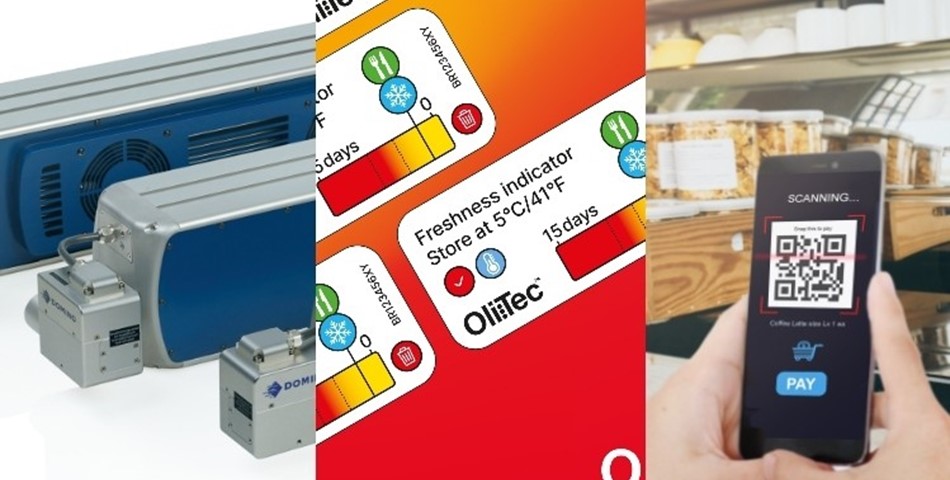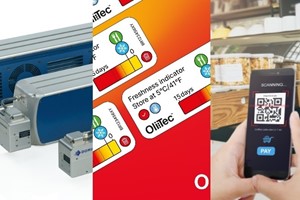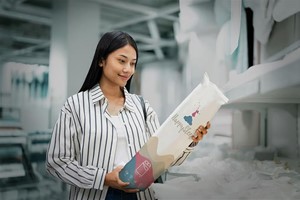Consumers need to know what’s in their food and customers need to know what product they’re moving around their warehouse, but as technology advances what’s the role of traditional labels in the food chain?
One of the more drastic approaches to printing and labelling in the food and drink manufacturing space has been to remove printed labels from the equation entirely. We have in the past seen examples of lasers being used to print directly on to food. The next step being explored, for example, by Domino Printing Sciences has been to use laser technology to codes into films used on food products.
The printing service provider describes its D-Series CO2 laser coders as an additive-free solution for food manufacturers using NatureFlex compostable cellulose films. The printing firm has collaborated with global packaging film producer Futamura to assess the suitability of laser coding for such film products.
Following initial suitability testing, the D-Series CO2 laser was used to code the film and achieved a clean, crisp, white code with no impact on film integrity or chemical composition. Moisture barrier properties were also unaffected.
Dr. Stefan Stadler, team lead at the Domino Laser Academy predicts that requests for compostable solutions will become more prominent in the coming years.
We are ready and willing to work with any brand exploring these new materials to help find the right coding solution for their individual requirements, he continued.
The films are designed to meet all the global standards for industrial composting, including BS EN13432, and are certified as home compostable under the OK Compost Home standard.
The option of laser coding a message onto the NatureFlex flexible film does not require additional materials on the compostable substrate, which could complicate final certification.
Clear cut winner
Six different variants of NatureFlex compostable film have been analyzed, with Dominos D120i laser found to have provided the best clarity and results at high printing speeds.
Amaia Cowan, Futamura UK business development manager for Europe, the Middle East and Africa said: We were reassured by Dominos scientific approach to substrate testing and coding and willingness to provide us with the results and assurance that we needed to confirm that laser coders are a suitable solution for our compostable films.
The results from the project are very positive. This new coding method will enable the inclusion of a message to consumers on the film itself, without printing. As no additional materials are added to the compostable films, seeking certification of the final packaging will be straightforward.
\The quality and clarity of the codes make laser coding on NatureFlex flexible film a good choice for food manufacturers looking to create best before dates and batch codes. However, it also suits more complex designs and messaging, including graphics and scannable 2D codes.
Pressure to reduce food and drink packaging and growing consumer demand for transparency from manufacturers have been important catalysts in the development of laser technology.
Regulatory compliance and production information specialist Ashbury argues that Quick Response (QR) codes could offer an effective solution to the space versus information challenge faced by brands when designing new labels.
QR Codes
Janet Dalzell, senior regulatory advisor at Ashbury, explains: Most UK consumers trust food labels, according to the new report by the Food Standards Agency. But they are growing frustrated by how difficult it can be to get to the truth 2019 when it comes to making food choices.
FSA annual review of food standards
Latest figures from the FSA Food and You 2 survey found more than eight in ten people (83%) are confident the information on food labels is accurate.
For those who shop for someone with a food allergy or intolerance, the same proportion (83%) felt confident in the allergen information provided on food labels.
Three in five (61%) say they often feel foods labelled as healthier options are unhealthy in other ways, and 37% want access to more consistent health information.
Consumers are thirsty for more information, but of course there’s only so much room available on a label to convey messages that align with what consumers want to know. It’s a challenging task for brands to balance mandatory legal information with their own marketing and sales objectives. There’s lots to consider, such as animal welfare, sustainability and environmental credentials, recycling, and more detailed product origin information all on the horizon.
The alcohol category has become a hotbed of labelling innovation, with electronic means of providing information gaining ground. This has largely been in part due to recent changes in EU law.
Beverages are still subject to general labelling requirements, such as naming the product and highlighting allergens. However, drinks containing more than 1.2% alcohol by volume are not required to display an ingredients list or nutrition information.
The EU was required by Regulation 1169/2011 to review this exemption for alcohols, with the process leading to the industry adopting a self-regulatory proposal. But in early 2021, the Beating Cancer Plan announced mandatory indication of ingredient and nutrition information for alcohols.
EU Rules
In December 2021, the Commission required the mandatory labelling of ingredients and nutrition indication for wines and aromatized wine products by September 2023. According to Dalzell, this may be on the label or via electronic means such as QR codes.
The potential for product information to appear online as opposed to on, or with, the packaging of the product, is certainly an interesting one says Dalzell. In theory, online information can be adapted and updated quickly, can provide additional information to those who are interested, can be adapted for many languages, and can be accessed from personal devices.
By Gwen Ridler











